- Home Page
- Better Kites
- ... Rokkaku Kite
How to Make a Rokkaku Kite
Step by Step—Page 2 of 3
The MBK 1-Skewer Rokkaku
How to Make a Rokkaku Kite
Spars
Now you need another two bamboo skewers. The photo shows them laid over the sail after being snipped to length with scissors.
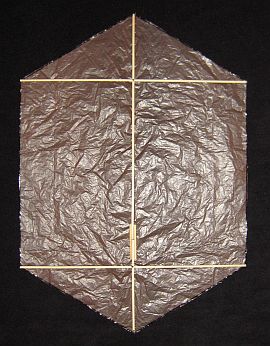
- Lay down the glued skewers over the center crease of the plastic, lining up the non-pointy end with the top corner of the plastic. Snip off the other end so the skewer lines up with the bottom edge of the plastic as well. As already mentioned, this is the vertical spar.
- Lay down another skewer across the top left and top right corners of the sail, and again snip to length, removing the point. Also, make an easily seen mark on the skewer at the exact center point. This is the upper horizontal spar.
- Using a sharp corner, perhaps a blade of the scissors, make an indent in the bamboo at the center point you marked.
- Lay down another skewer across the lower left and right corners of the sail. Snip, mark, and indent just as you did for the upper spar. This is the lower horizontal spar.
How to Make a Rokkaku Kite
Attaching Sail
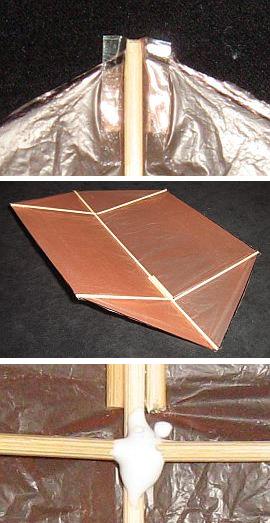
- Lay down the vertical spar skewer over the sail, and wrap a short length of clear sticking tape around each tip, securing them to the top and bottom corners of the sail. The top photo shows the top tip in closeup.
- Lay down the upper horizontal spar skewer, and attach its tips to the left and right corners of the sail in the same way.
- Now do the same for the lower horizontal spar skewer.
- Bend each horizontal spar in the middle until it starts to crack at the indent! Carefully increase the bends until you can get the kite looking like the one in the middle photo. Note that the lower spar has a little more dihedral (angle) than the upper one. Don't worry if the bent part feels weak, since glue will make it strong enough:
- Dribble some wood glue all around where the skewers cross each other. See the bottom photo.
- Wait for the glue to dry.
How to Make a Rokkaku Kite
Bridle
Dacron line in 20- to 50-pound strength is suitable for all the Skewer Series kites.
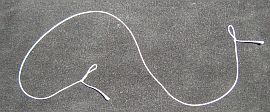
- Cut off some Dacron line to a length of 2.0 SL (58 cm, 23 in.), and tie a very small Loop knot into each end. See the photo.
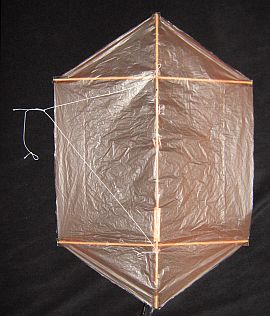
- Poke a hole in the plastic sail just above where the upper horizontal spar crosses the vertical spar.
- Poke another hole in the plastic sail just below where the lower horizontal spar crosses the vertical spar.
- Poke the Loop knots through the holes, and tie off around the vertical spar with a Double-Wrap Slip knot.
- Now take a length of flying line about half a skewer long, and tie one end to the bridle line with a Prusik knot. Tie a small Loop knot into the other end. There's the whole bridle in the photo.
- Secure each knot on the vertical spar with a tiny blob of wood glue.
How to Make a Rokkaku Kite
Tail
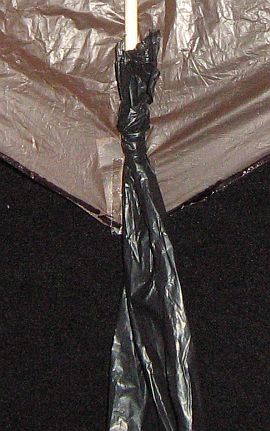
- Cut out a long thin rectangle of colored plastic for the tail. Mine is black to contrast with the orange sail. Make it 8.0 SL (230 cm, 90 in.) long and 0.2 SL (5.8 cm, 2 1/4 in.) wide. Knot pieces together, if necessary, to get the full length. Avoid taping, because it adds weight!
- Tie one end around the vertical spar as close as possible to the bottom tip. See the photo. A single Half Hitch will do, since there are very low forces on the tail in flight. Snip off the excess plastic so the knot is neat and tidy.
At this point, you've finished making the 1-Skewer Rokkaku!
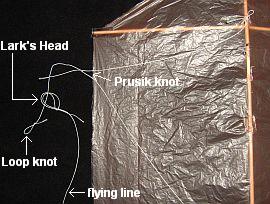
To attach the flying line, just Lark's Head the flying line to the short kite line as in the photo.
As mentioned earlier, there's more kite making on this site than you can poke a stick at. :-)
Want to know the most convenient way of using it all?
The Big MBK E-book Bundle is a collection of downloads—printable PDF files which provide step-by-step instructions for many kites large and small.
That's every kite in every MBK series.
